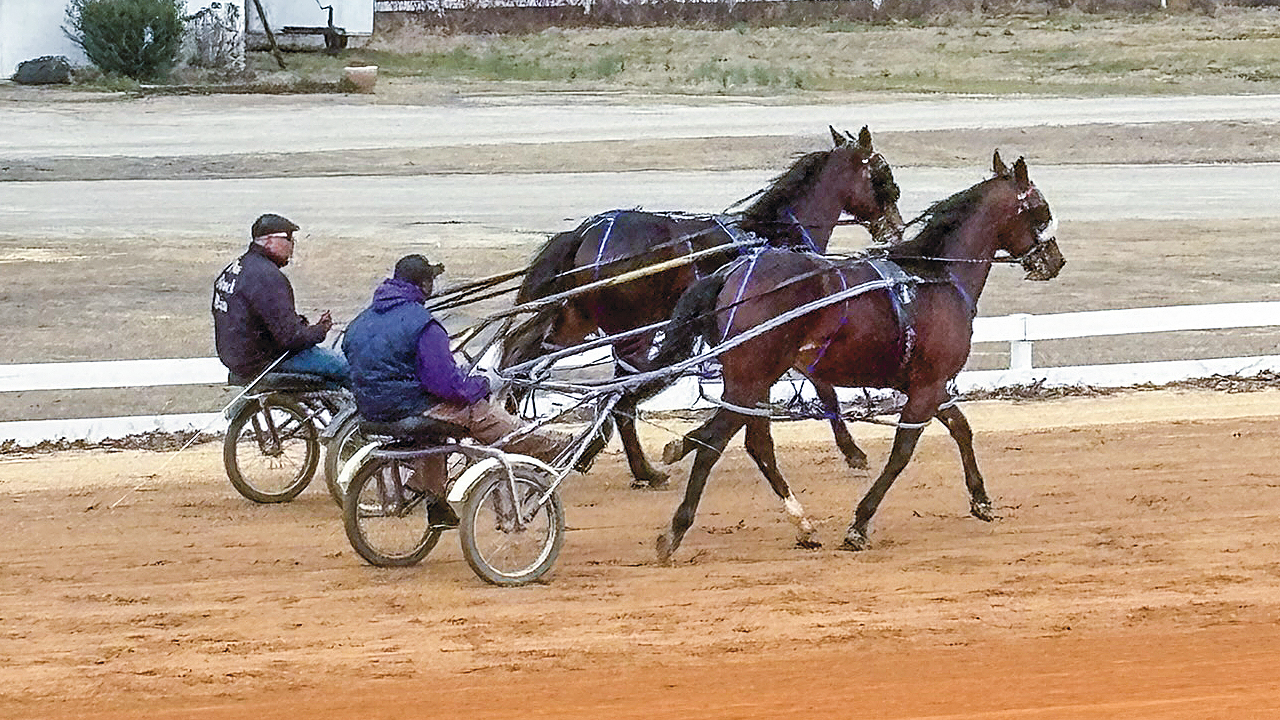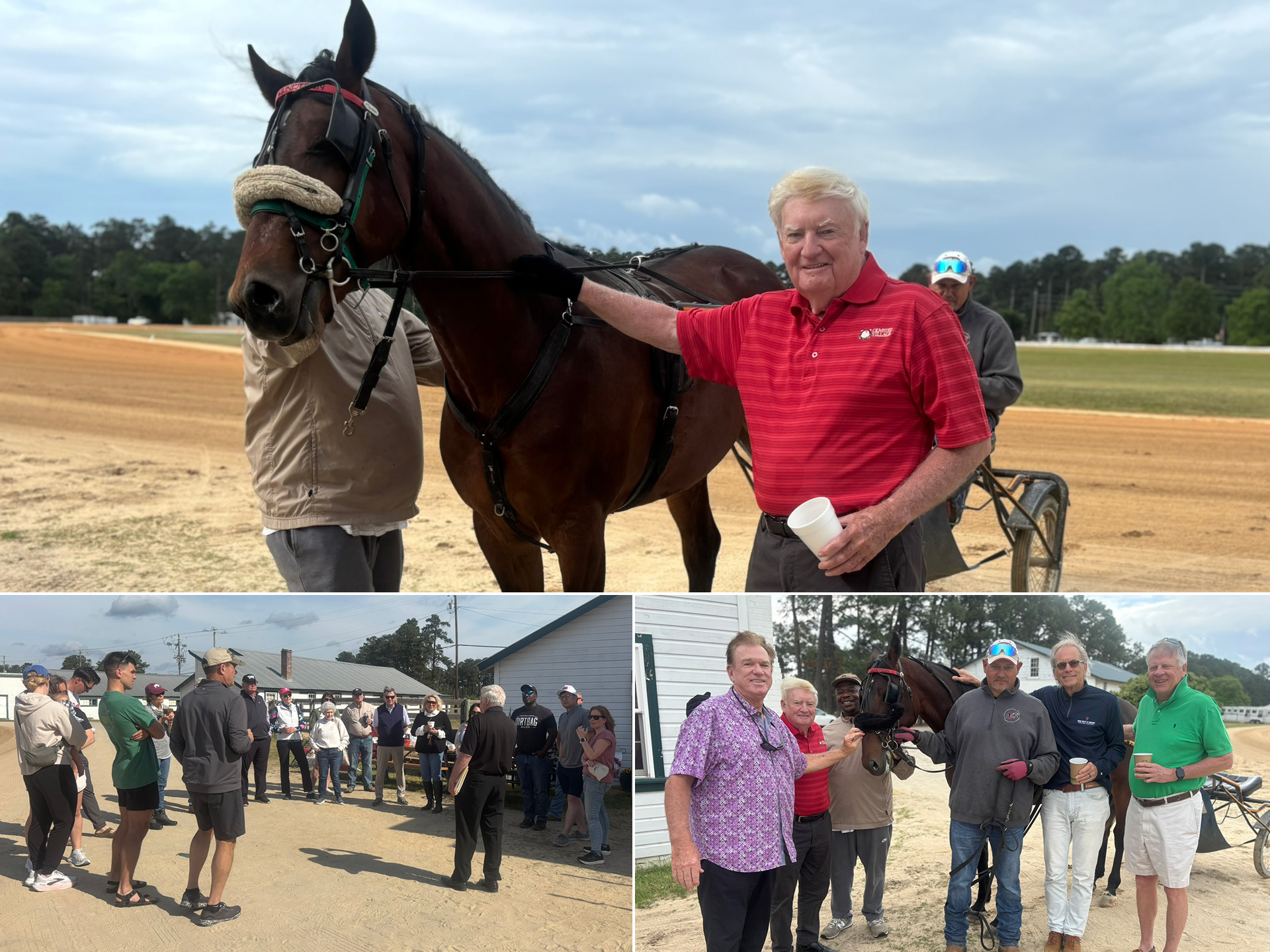Marty McKenzie on a mission to save a Pinehurst landmark
Pinehurst, N.C., is known worldwide for golf and boasts 42 courses, including five designed by the legendary Donald Ross. But it has also been a haven for harness racing for well over a century and home to a litany of Hall of Fame performers. While this beautiful destination is steeped in history and guarded by preservationists, there is one unprotected location that a lifelong resident of the community is on a mission to bring under that same umbrella.

“Pinehurst is the oldest continuously operated equine sports facility in North Carolina, and the value of it goes well beyond its actual worth.”
– Marty McKenzie
The story of Pinehurst began in 1895, when Bostonian James Walker Tufts purchased roughly 5,500 acres of land to build it. Tufts, who made his fortune with the American Soda Fountain Company, had to start from scratch with all the necessary infrastructure needed for the village, including water, sewer, electricity and roads.
Tufts hired Frederick Law Olmsted to design the land and architecture to mirror that of his New England home. Olmsted planted almost a quarter million trees and shrubs, designed to display an attractive evergreen landscape in winter and an array of colorful flowers in the spring through winding paths in the village.
Golf was first introduced to Pinehurst in 1898 by hotel guests who were seen hitting little white balls in the fields that surrounded the town. Soon after, a simple nine-hole golf course was constructed. It was eventually expanded to 18 holes and became known as Pinehurst No. 1.
In 1900, Pinehurst began hosting equestrian events, including harness racing, to expand the entertainment opportunities for their resort guests, and it didn’t take long for visiting horsepeople to realize that the climate was perfect for winter boarding and training of horses. The village soon became a major draw for a winter training center for trotters — predating Florida’s Ben White Raceway — and to this day has remained a preferred spot to prepare young horses in the offseason.
Pinehurst is well known for its spring matinee races that annually draw crowds of up to 5,000 people, and the site of the training facility and both the half-mile and five-eighths-mile tracks was placed on the National Register of Historic Places in 1992. Then, in 1996, it was designated a National Historic Landmark, the same designation Goshen Historic Track had received 30 years earlier. However, there is one part of this harness racing campus that does not fall under that protection: the mile track. And today, that parcel of land is quite valuable to developers who have recently been eyeing it.
Enter Marty McKenzie — known to most in town as “Mr. Pinehurst” because he is probably the village’s most knowledgeable and affable resident. He owns the Olmsted Village Company, which has specialized in commercial real estate development on site in Olmsted Village, for almost 40 years, and he is also responsible for building and managing major developments in nearby Southern Pines.
“Pinehurst is the oldest continuously operated equine sports facility in North Carolina, and the value of it goes well beyond its actual worth,” said McKenzie. “The mile track is the real reason these horsemen keep coming back every winter, and, oddly enough, it’s the one thing that’s not protected, so we have to change that.”
An avid golfer, McKenzie boasts one of the lowest membership numbers (three digits) on file at the Pinehurst Country Club due to his tenure there. But his love of harness racing started at birth 80 years ago as his family lived in a house on the backstretch.
McKenzie was born in Pinehurst, the son of William “Mac” McKenzie, who managed the training center and also built the one-mile red clay track in 1952.
“For the first eight years of my life, I lived in a house just 25 steps from the five-eighths-mile track. On the other side of the house was the second green and third tee of the No. 1 golf course, so I grew up with a 5-iron in one hand and a horse whip in the other,” joked McKenzie. “In the summertime, it was pretty laid back. But in the fall, all the horsemen and their families would ship in, and the real action got underway getting the young horses ready to race the following year.”
McKenzie attended Pinehurst High School and played basketball and golf while there before eventually going to college at the University of North Carolina. And throughout his life, he always had horsepeople as friends because he lived among them for many years.
“As a kid, I never really understood where the horses went when they left,” said McKenzie. “But when I got older, I was very good friends with Gary Cameron. And one summer when I was home from college, I went up to Brandywine Raceway to watch him race, and I immediately fell in love with the business. I ended up working with the horses for two summers and traveled all over the U.S. and Canada. The people I met in harness racing throughout my life are the nicest, kindest and most patient people I have ever known.”

McKenzie explained that over the years Pinehurst took many twists and turns as ownership of it changed hands several times. And, whereas the golf industry ebbed and flowed as a result of different management, the horses remained a constant.
“Pinehurst was owned by the Tufts family since its inception until they sold it to Malcom McLean through his Diamondhead Corporation in 1970,” McKenzie explained. “They knew McLean because he was from North Carolina and ran a small trucking company in the 1940s that moved baggage for Tufts’ hotel. He eventually sold McLean Trucking by the mid-1950s and actually invented overseas container shipping. His company, named Sea-Land, became the industry standard in a market that is now worth in excess of $610 billion annually.”
McLean sold Sea-Land to R.J. Reynolds Co. for $530 million in 1969, which was just prior to him buying Pinehurst for $9.2 million. At the time of the sale, Pinehurst consisted of 9,000 acres and included five golf courses, the hotel, the training center and the town.
“Under Diamondhead management, the 1970s in Pinehurst was a debacle,” said McKenzie. “Everything here took a step back, and in 1980 the banks took over everything. At that point, the town incorporated itself and the banks sold the golf course to Robert Dedman Sr. of the Club Corporation of America, and it has thrived under their ownership ever since.”
In 1952, when Tufts still owned the training center, he leased it to the horsepeople’s association for 40 years. In 1992, the lease came up while the bank still owned the 111 acres after their 1980 takeover — and that same acreage was also being eyed as the next condominium project. But the village of Pinehurst ended up buying the parcel to protect it from any development.
“In 1996, the Pinehurst training center received National Historic Landmark status, but it did not include the mile track because a site had to be at least 50 years old and at the time it was only 44 years old,” said McKenzie. “But it’s old enough now, and I want the mile track added to the landmark status to protect it from any kind of development in the future.
“The town owns the entire 111 acres that includes the mile track, and my concern is that long after we’re gone, some rogue town council gets in there who cares nothing about harness racing and sells it to make a quick profit while overlooking its significance to the community. Developers are very interested in that parcel of land.”
“To see the smiles on these people’s faces and their children and grandchildren when they watch their horses has been a wonderful experience.”
– Marty McKenzie
McKenzie’s plan is to get enough financial and people power to be able to take the mile track away from the village council and government and put it into some sort of trust or conservancy to make sure it’s always protected and managed by people in the business.
“Recently, there have been no Standardbred owners living in Pinehurst, so I wanted to get people who live here involved and actually owning pieces of harness horses so they get to know the sport,” he said. “We have so many successful and intelligent people in Pinehurst. It’s small change to ask them for a little bit of money to buy into a horse, but nobody has ever asked them. Once I got them on board and they began to understand what a treasure harness racing here is, it changed everything.
“We started with one horse, developed a budget, and got everyone to write a check for a share. The first venture was so successful that we bought two more horses around the same budget. Right now, we have 45 individual participants — only from Pinehurst — involved in ownership with horses currently training here and staked in Ohio. With spouses or friends, there are about 80 people now in our group, and we are looking to expand again next year. To see the smiles on these people’s faces and their children and grandchildren when they watch their horses has been a wonderful experience.”
McKenzie and his syndicate are known as Pinehurst Racing Partners, and they are passionate. Their horses — Nathan’s Honor, Strong Proof and Sum Lad — were trained in Pinehurst by Scott Freeman all winter and are eligible to all Ohio stakes this summer, starting on July 13 at MGM Northfield Park. The group meets every Saturday to watch the horses train, and they have all embraced how important harness racing is to their community.
Now, with the support of his ownership group, McKenzie plans to sit down with Pinehurst town managers to discuss the steps needed to move forward with making the mile track a National Historic Landmark, and then devise a plan to put it back in the hands of the horsepeople who have kept it alive since the early 1900s. McKenzie also believes Pinehurst offers a real opportunity to expand the exposure of harness racing to the entire nation.
“Currently, Pinehurst draws in excess of 1.2 million golfers a year. These golfers come from every part of the country and from all over the world, and they play right next door to the harness tracks,” he said. “These people all have a lot of money to spend, and they all like sports. So, we have a captive audience that could become active owners in harness racing if we can just make them aware of the sport while they’re here. These people can see the horses jogging on the track while they are teeing off, so it basically sells itself. We just need to put a little more polish on it to draw them in.”
The Pinehurst training center is one of the greatest green belts any town could wish for. It’s a park-like setting that everyone is welcome to come and enjoy at any time. And its story includes ties to a number of Hall of Fame horsepeople, including Doc Parshall, Charley Lacey, Frank Safford, Del Cameron, Percy Gray and Octave Blake; and horses Tar Heel, Knight Dream, and Trotting Triple Crown champion Marion Marauder, who trained out of barn No. 3.
“To me, there are only three things in this town that make Pinehurst what it is: the Pinehurst No. 2 golf course, the village of Pinehurst itself, and the harness tracks,” concluded McKenzie. “If you take any one of those away, you just have rural North Carolina.”
This piece appears in the June 2025 issue of Hoof Beats, the official magazine of the USTA. To learn more, or to become a subscriber to harness racing’s premier monthly publication, click here.
